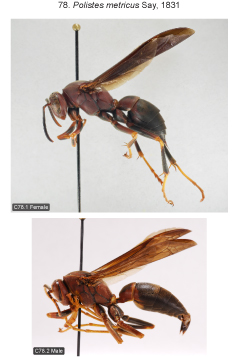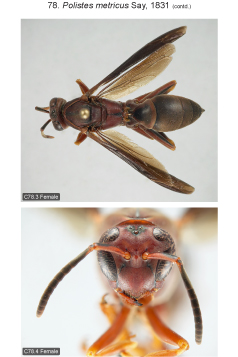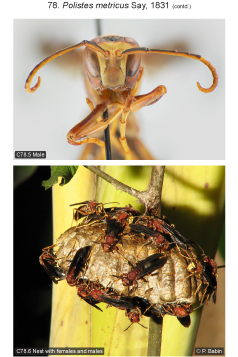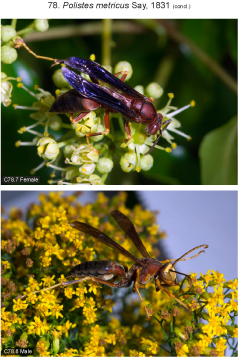
| Home | Table of contents | Keys | Species list | Glossary | Image data | PDF | Cite this article | Feedback | Updates |
Identification Atlas of the Vespidae (Hymenoptera, Aculeata) of the northeastern Nearctic region
CJAI 05, February 19, 2008
doi: 10.3752/cjai.2008.05
Matthias Buck, Stephen A. Marshall, and David K.B. Cheung
Department of Environmental Biology, University of Guelph, Guelph, Ontario, Canada N1G 2W1
Next species | Previous species | Key
78. Polistes metricus Say, 1831
Figs B10.17, 22, 24, 27, 36, 52; C78.1–8.
 |
 |
 |

Species recognition. Female very similar to some ferruginous colour forms of P. fuscatus. Polistes metricus has very restricted yellow markings (as in some P. fuscatus), but the mesosoma is more extensively ferruginous while the metasoma is mostly black (see key). Unlike P. metricus, ferruginous specimens of P. fuscatus often show ferruginous markings beyond metasomal segment 2. The convexity of sternum 2 (more pronounced in P. metricus) provides an additional morphological character, but the difference is sometimes quite subtle.
Variation. Fore wing length 14.0–21.5 mm (♀♀), 14.5–18.0 mm (♂♂). Female on one extreme with almost entirely ferruginous head and mesosoma (excluding black dorsal surface of flagellum, pedicel and distal third of scape, narrow ocellar rings, some mesosomal sutures), on the other extreme ferruginous marked with considerable black as follows: large spot around ocelli extending from eye to eye, marks below and above each antennal socket, spot on interantennal prominence, occiput, most of pronotum in front of pronotal carina, scutum except a pair of ferruginous, posteriorly convergent or connected stripes and a pair of spots opposite tegula, mesopleuron except spots behind and in front of scrobal furrow and on lower mesopleuron, metapleuron around edges and upper pit, pair of propodeal stripes (very rarely so; propodeum usually ferruginous with more or less developed black median stripe). The metasoma is largely black and shows ferruginous markings as follows: apical fascia and lateral margins of tergum 1 usually, pair of discal spots and lateral margins of tergum 2 often, base of sternum 2 rarely. Femora usually with black to dark brown markings, sometimes absent on fore and mid femur, always present at least ventrally on hid femur. At least hind tibia with dorsal surface largely black to dark brown (excluding yellow base). Yellow markings restricted to propodeal valvula (sometimes ferruginous) and rarely tergum 1 (apical fascia). Male similar to female but black markings sometimes more extensive, e.g., 1 ♂ from IN: Lafayette (CNCI), with entirely black scutum, black posterior half of mesopleuron (except ferruginous dorsal spot), black metapleuron (except ferruginous dorsal spot) and black propodeum with wide lateral and narrow paramedian ferruginous stripes. Yellow markings include (in addition to those present in female): entire face to level of upper eye emargination (in some specimens median portion of clypeus and area between and below antennal sockets more or less ferruginous), pronotal carina sometimes, extreme ventrolateral corners of pronotum usually, anteroventral area of mesopleuron to level of ventromedial suture (very variable, from very large area to completely absent), usually large basal spot on sternum 2, apical fasciae on sterna 2–4 (often absent on 2 and 4, sometimes sterna 2–4 completely dark). Extent of yellow markings on legs also extremely variable: some yellow present at least on mid coxa (always?, sometimes suffused with ferruginous), base of mid and hind tibiae and all tarsi; xanthic specimens with anterior surface of all coxae, trochanters, femora and tibiae yellow.
Distribution. Canada: newly recorded from extreme southwestern ON (2 ♀♀, Pelee I., DEBU). Eastern U.S.: ME (1 ♀, Dryden, CNCI; new state record, probably adventitious), NY, PA, southern OH south to FL, west to NE, KS, OK and eastern TX (Richards 1978).
Biology. Nests are built in both sheltered and exposed places (eaves of roofs, trees, shrubs). Prey consists mostly of caterpillars (Isely 1922).
Next species | Previous species | Key
| Home | Table of contents | Keys | Species list | Glossary | Image data | PDF | Cite this article | Feedback | Updates |
